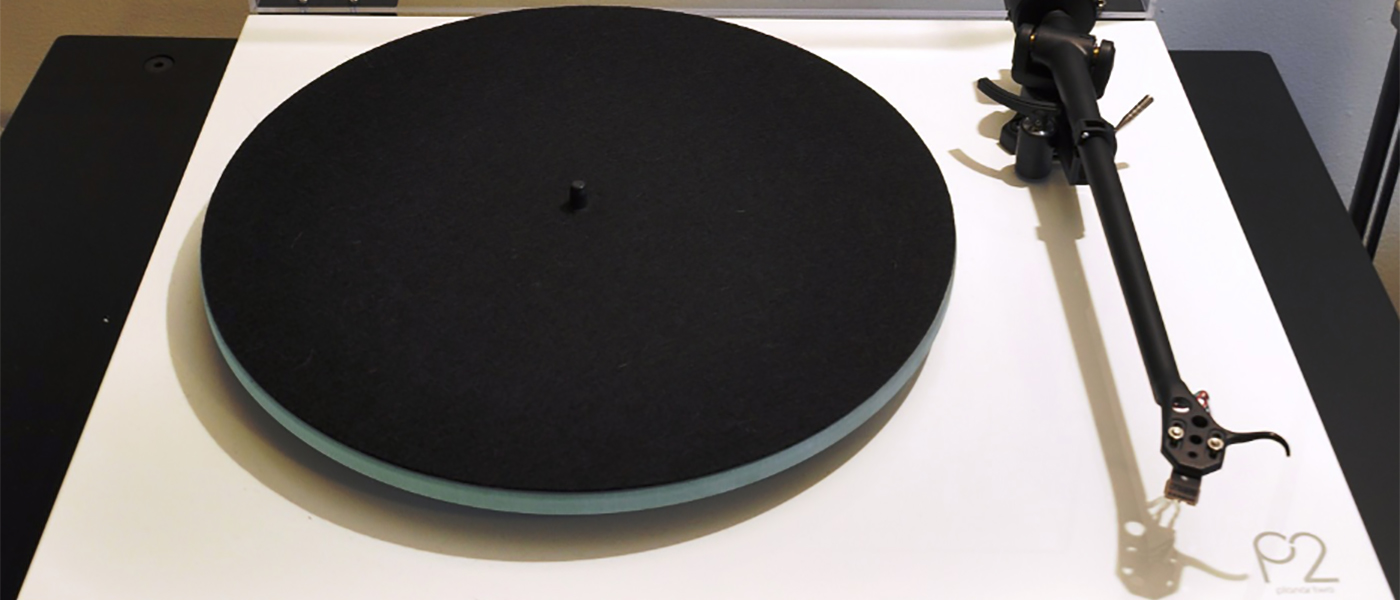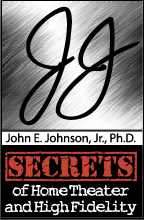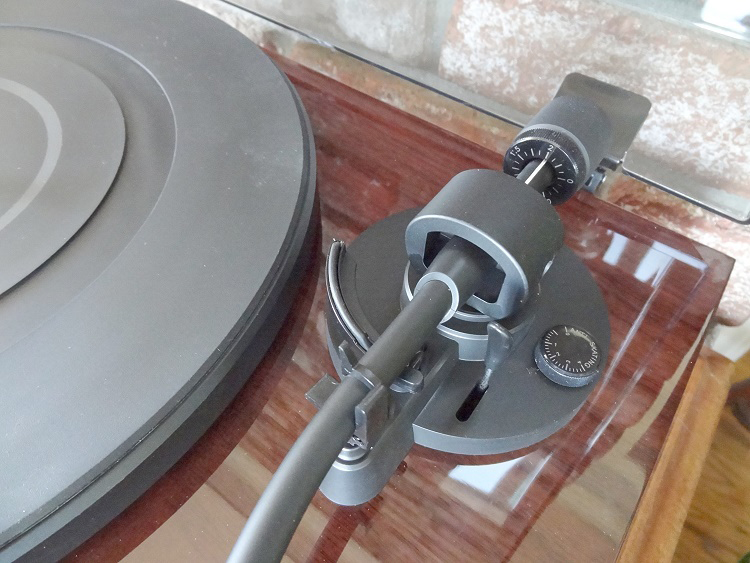Fluance, a company that offers speakers, both wired and wireless, recently began marketing turntables whose engineering was funded by KickStarter.
The RT81 is now available (June, 2016). At $249.99, it is an amazing value. It comes with a cartridge pre-mounted in the headshell and a built-in phono preamplifier. It is an entry-level turntable, aimed at the consumer who is beginning to purchase LPs.
The base of the RT81 has real walnut veneer with a high gloss finish that is truly beautiful.
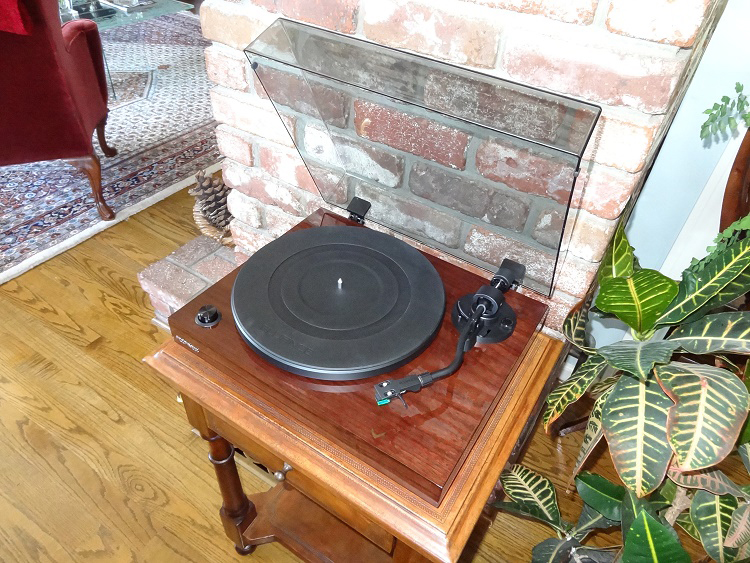
Fluance RT81 Turntable with Cartridge and Phono Preamplifier
- Amazing price for what you get
- Pre-mounted cartridge and pre-aligned tone arm
- Built-in phono preamplifier
- Beautiful real walnut veneer with high gloss surface
Vinyl has re-emerged as a major force in the world of music. Some companies are reporting huge increases in the sales of LPs compared to last year, and the market was already incredible. Many musicians are making sure that the production of an LP is part of their contract, with the regular production of a CD.
DESIGN:
Turntable with Cartridge Pre-mounted in the Headshell and Tonearm Pre-aligned; Built-in Phono Preamplifier
SPEED:
33 1/3 RPM and 45 RPM
DRIVE SYSTEM:
DC motor and belt
CARTRIDGE:
Audio Technica AT95E, MM
STYLUS:
0.4 × 0.7mil Bonded Elliptical Diamond
TRACKING FORCE:
2 Grams
PLATTER:
Aluminum
TONEARM:
Aluminum, Static Balanced, S-Type, Pivot Bearing
ANTI-SKATE ADJUSTMENT:
Yes
CHANNEL SEPARATION:
20 dB
LOAD IMPEDANCE:
47 kOhms/100 pF
FREQUENCY RESPONSE:
20 Hz – 20 kHz
WOW & FLUTTER:
0.2%
SIGNAL TO NOISE RATIO:
60 dB or Greater
PHONO OUTPUT:
140 mV
DUST COVER:
Yes
DIMENSIONS:
5.5” H x 16.5” W x 13.75” D
WEIGHT:
14 Pounds
MSRP:
$249.99 USD
Company:
SECRETS Tags:
Fluance, RT81, Turntables, Cartridges, Tonearms, Phono Preamplifiers
The RT81 is an entry-level product. It is not designed to compete with the ultra-high-end turntables that cost thousands of dollars. It is designed for consumers who are wanting to start purchasing vinyl. Down the road, maybe, you might purchase one of those turntables in the multi-thousand-dollar range.
However, a consumer can be an audiophile, having equipment at any range in price. The components do not have to be expensive in order to enjoy the wonders of LPs.
Turntables are analog as compared to CDs, and the sound is distinct, and certainly pleasurable. I found this to be true with the RT81 even though my reference turntable (VPI HR-X: Vinyl vs. CD – A Running Commentary – Parts 1 – 5), cartridge (Sumiko Blackbird: Vinyl vs. CD – A Running Commentary – Parts 1 – 5), and phono preamplifier (Manley Labs Steelhead: Vinyl vs. CD – A Running Commentary – Parts 6 – 9) represent a $22,000 investment.
Secrets Sponsor
The RT81 has a lot in common with much more expensive turntables, and actually, I was shocked at how many features it has. For example, the platter, which is aluminum with a rubber disc to separate the LP from the metal platter, is belt-driven, which is generally considered to be the best way to isolate the motor from the platter.
The tonearm is also aluminum, with a nice pivot. There is also an anti-skate adjustment, which counter-acts the tendency for the cartridge to move inward towards the center of the LP.

The rear panel of the RT81 allows you to use either the phono preamplifier output or the cartridge output if you already have a phono preamplifier. It also lets you to select the automatic turn off that occurs when the LP is finished playing.
Although there are numerous other tonearm adjustments, Fluance has pre-adjusted most of them for you.
The included cartridge is already mounted in its headshell, but it is packed separately. You insert the headshell into the front of the tonearm socket and lock it into position using a ring that is in between the headshell and the front of the tonearm.
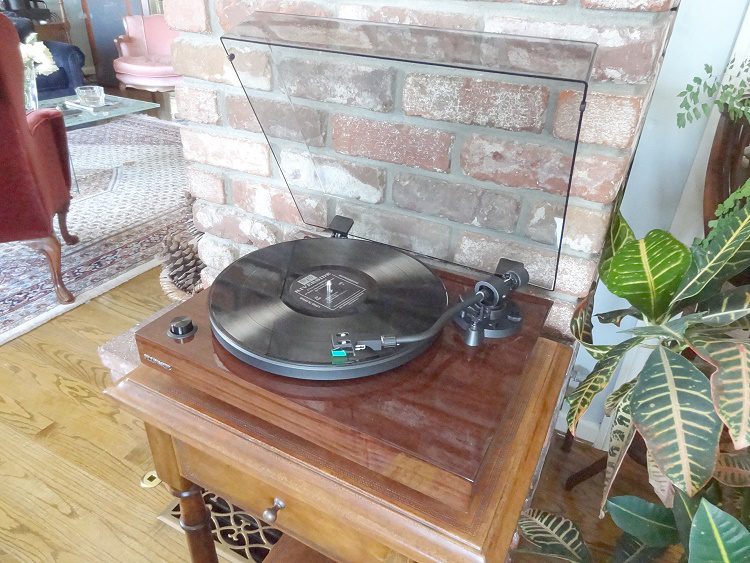
I used the RT81 in the two-channel lab (Lab 3), which has a Balanced Audio VK5i tube preamplifier, Balanced Audio VK-75SE tube power amplifier, and Magnepan 20.7 Planar Magnetic full-range speakers.
Since the RT81 has a built-in phono preamplifier, I simply used one of the standard inputs on the VK5i. Although the RT81’s phono preamplifier is not in the same class as my reference $8,000 Manley Labs Steelhead phono preamplifier, it is sufficient in an entry-level turntable, and theoretically, it is advantageous for the phono preamplifier to be electrically connected in the turntable rather than having to use RCA plugs and jacks with the cable that normally connects the cartridge output on a turntable to the input on the separate phono preamplifier.
Secrets Sponsor
I checked the alignment of the arm, and it was spot on, except for the azimuth (see below), which is adjustable.
As seen in a previously published article: Vinyl vs. CD – A Running Commentary – Parts 1 – 5, there are a number of alignments that need to be performed when setting up a turntable.
First is the Tracking Force. Please take a look at the link above, which takes you to our article that discusses all the setup procedures.
The RT81 has an adjustment for tracking force, which involves placing the counter-weight on the rear end of the tonearm, pushing it forward (towards the cartridge) until it clicks into a detent (groove), then turning the counter-weight so that the arm “floats” above the platter, so that the tonearm does not move up or down. Hold the tonearm between two fingers, so that it does not fly upward or accidentally fall onto the platter.
Then, you lock the tonearm into its resting position. You turn a dial that is in front of the counterweight to 0, followed by turning the entire counter-weight counter-clockwise to “2”. That sets the tracking force to 2 grams.
Below are some photos showing the counter-weight dial at 0 and at 2.
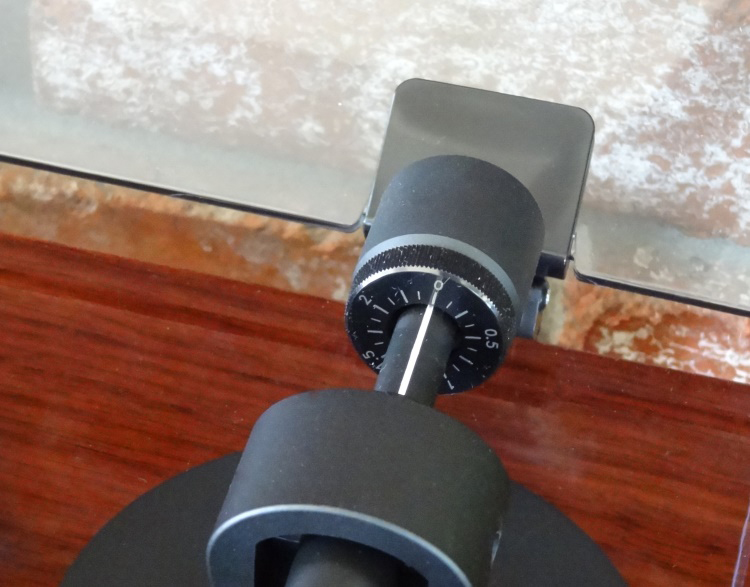
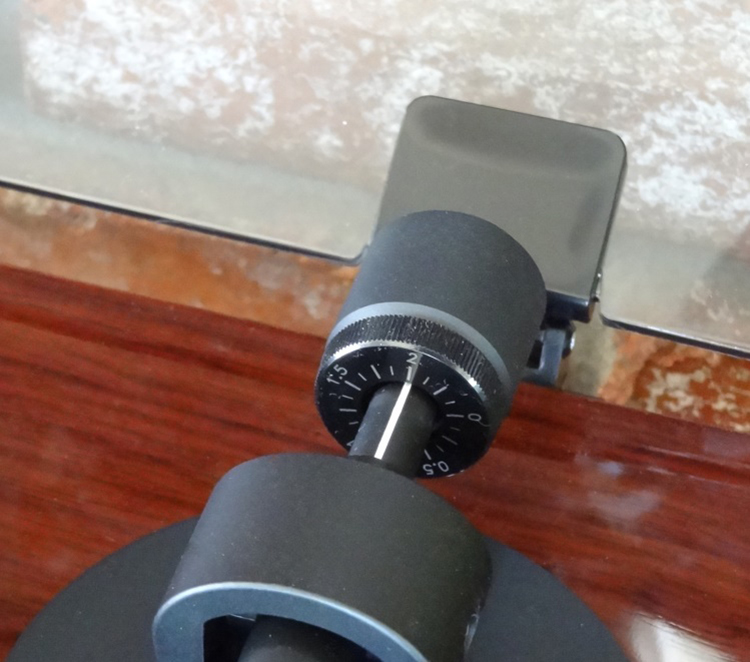
I think it is important to always measure the tracking force, rather than depending entirely on a dial, because it is a critical part of proper cartridge function. An inexpensive gauge can be purchased on the Internet. Just Google “Phono Cartridge Tracking Force Gauge”, and you will have many to select from. If you are getting into vinyl, you will want to have a gauge to confirm the proper tracking force. You can purchase an inexpensive mechanical tracking force gauge ($25) or a digital gauge (about $80). Tracking force gauges are a good investment, especially if you eventually get an expensive turntable.
I measured the tracking force after setting the counter-weight to 2 grams, using a Clearaudio mechanical tracking force gauge, and it was 2 grams, so turning the counter-weight to 2 was accurate.
Here is a photo of the tonearm pivot. At the bottom right on the pivot platform is a small dial, which indicates the anti-skating force. You set this to the same number as the tracking force, which in this case, is 2 grams.
Also, there is a small lever that you can see on the pivot platform which keeps the tonearm above the LP. When you are ready to set the stylus into the lead-in grooves of an LP, you place the stylus above the grooves, holding it carefully, then release the lever by pushing it towards the front. At that point, you set the stylus into the lead-in grooves. You can raise the tonearm at the end of playing an LP by putting the lever back into its vertical position, and then placing the tonearm back in its resting place on the pivot platform.
Secondly, the Vertical Tracking Angle (VTA) is the tilt of the tonearm as the cartridge stylus is in the groove of an LP.
Here is a photo that shows the VTA of the RT81 is excellent. Notice that the space between the body of the tonearm (the aluminum tube, not including the headshell) and LP is constant.
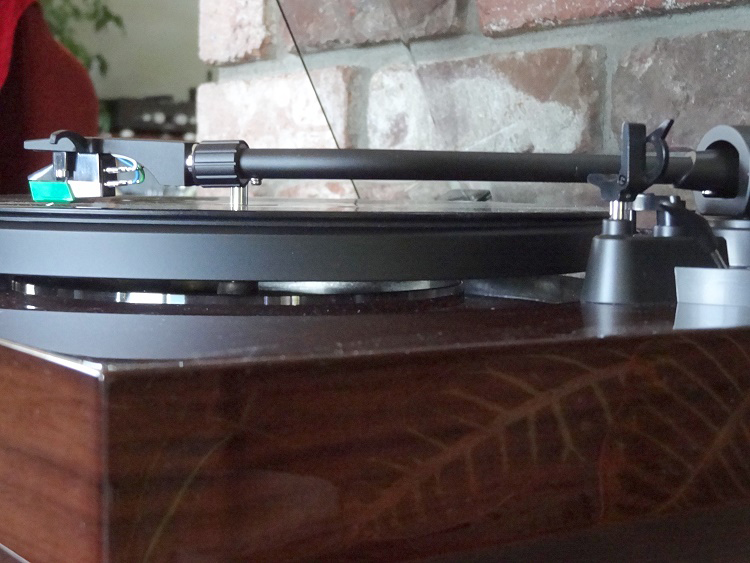
Third, the Azimuth refers to having the cartridge not tilted to the left or right, i.e., when looking at the front of the cartridge, not having the left side closer or farther from the surface of the LP than the right side. Shown below is a photo of the front of the cartridge on the RT81, illustrating that the azimuth is properly set by the factory.
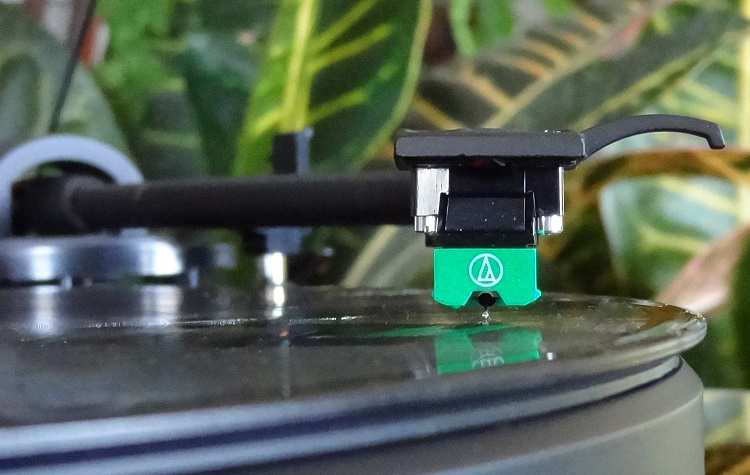
Fourth, the Horizontal Tracking Angle, also known as the Zenith, is set by adjusting the mounting screws that hold the cartridge in the headshell so that the cartridge is perpendicular to a line drawn from the center hole of the LP to the outside edge, and a line drawn through the body of the cartridge (front-to-rear) as the stylus is in the groove.
In the diagram shown below, the red line indicates proper alignment of the cartridge in an LP groove, with the line being the front-to-rear axis of the cartridge, perpendicular to the line drawn from the center of hole in the LP, and tangential to the circular LP groove. The two stereo channels, located at opposite 45 degree angles beneath the horizontal plane of the LP, would be tracked correctly by the cartridge stylus. The blue line indicates improper cartridge alignment, and is non-tangential. In this case, the stylus would not be tracking the two stereo channels correctly. Tangential means that a line that intersects a circle only intersects it one time if the line is extended in both directions. You can see that if the red line is extended, it would not intersect the circle a second time, while the blue line would intersect it a second time as shown below.
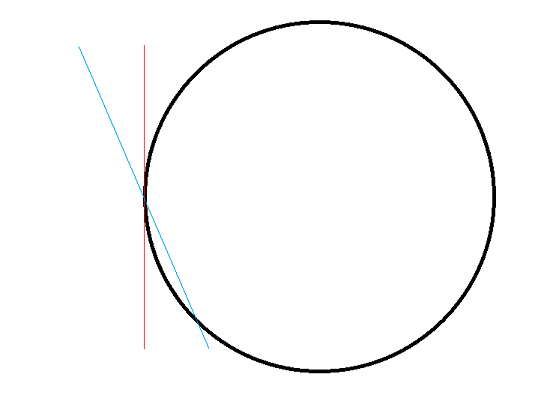
Because the cartridge moves in an arc, the best that can be done is to have it exactly line up in two points across that arc. The rest of the time, it will be just a bit off. The reason this is important is that with the right channel on the outside edge of the groove and the left channel on the inside edge, if the cartridge is not tangential to the LP groove, the stylus will bleed information between the channels. Increased distortion also results.
For this measurement, I used the MoFi Geo-Disc (about $45). A photo of the factory alignment is shown below. You can see that the cartridge headshell is not perfectly aligned, with the two screws holding the cartridge in the center of the two oval holes through which they attach to the cartridge. This implies that the cartridge is also not aligned either.
It is fortunate that this is one adjustment that can be changed on the RT81 by the user, whereas most of the others, such as the vertical tracking angle and azimuth, are not. So, I would suggest loossening the screws and twisting the cartridge so that it is slightly more to the right side (do this at your own risk).
You can also purchase the Geo-Disc if you want a more accurate measurement of the cartridge’s horizontal tracking angle, and you can change this, and then check the change with the Geo-Disc (there are also other, less expensive devices on the market for measuring the horizontal tracking angle).
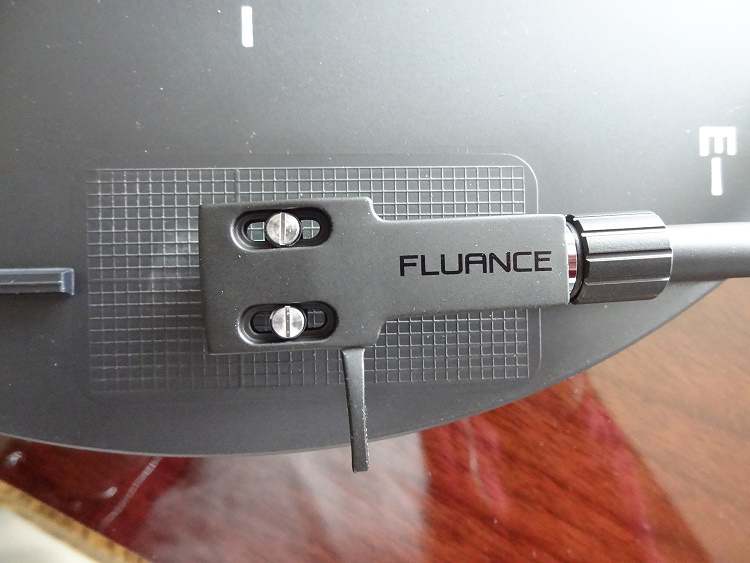
Another option for setting the horizontal tracking angle is that you can draw a straight line on a piece of paper, using a pen with a fine point, then punch a hole at the end the line (the end at the center of the paper) for the LP spindle, mark the line with a dot at 4-23/32″ from the center of the spindle hole, place the paper on the turntable, and put the stylus on the dot. Then, adjust the cartridge so that its front-to-rear axis is perpendicular to the line that you drew (do this at your own risk).
Here is a photo showing the cartridge re-aligned, and you can see the small amount of adjustment that I made in offset of the two screws holding the cartridge. The bottom screw is slightly more forward than the top screw.
I did my listening tests and bench tests with the cartridge in the factory-aligned condition, as some consumers would not want to bother re-aligning the cartridge. The sound was satisfactory without the re-alignment.
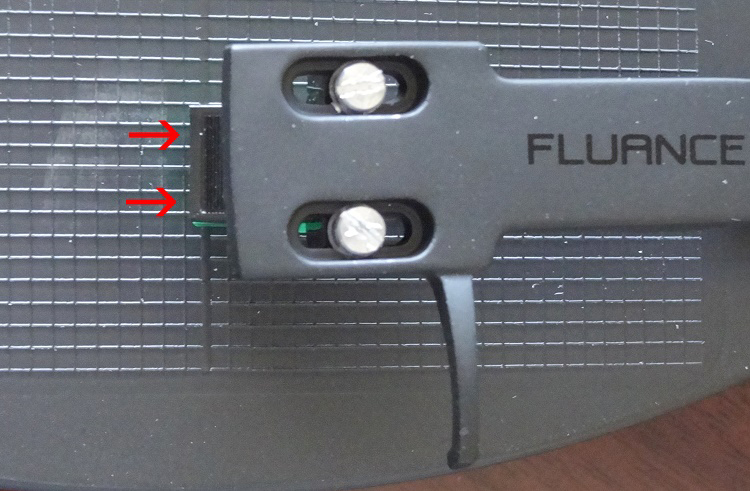
I have many LPs, which are mostly jazz albums, re-mastered from the original analog tapes from the 1950’s and 1960’s. Most of them have been released at 45 rpm, rather than the original 33-1/3 rpm versions. This increases the fidelity of the sound. I played albums of both speeds as part of the listening tests.
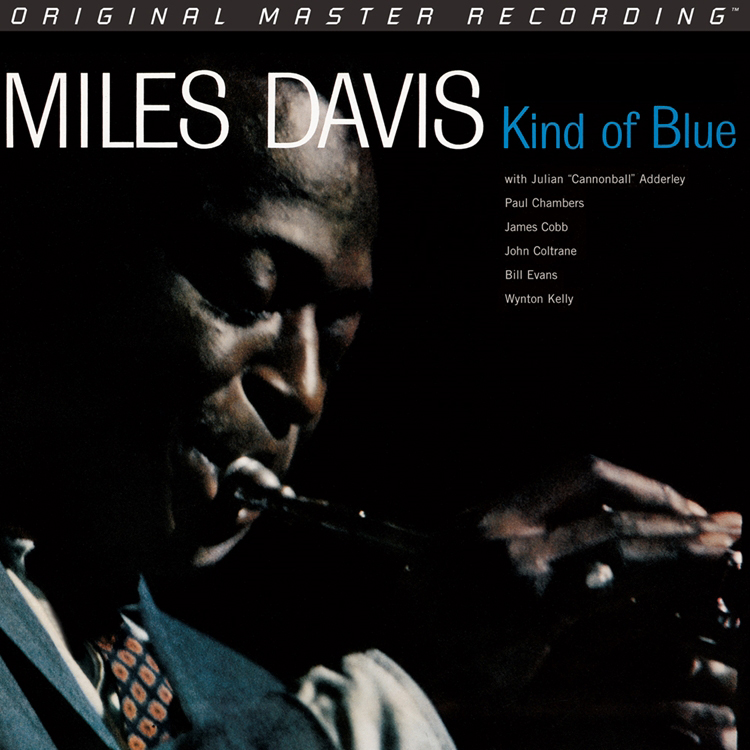
Kind of Blue (Legacy, ALEG 80571) is the most famous classic jazz album that has ever been released. It had not only Miles Davis, who headed up the group, but also Cannonball Adderly, Paul Chambers, Jimmy Cobb, John Coltrane, Bill Evans, and Wynton Kelly. It is truly a fabulous album and is available on all formats, including LP, CD, and SACD.
All of the tracks are excellent, but the first one, “So What”, is the track that one usually hears on the radio. It sounded very good using the RT81. It didn’t have the detail that my reference vinyl equipment has, but it really surprised me how much detail there was.

Romeo & Juliet, by Tchaikovsky, with Charles Munch conducting the Boston Symphony Orchestra, on RCA, is one of the first classical recordings I obtained (a gift from my girl friend whom I married in 1968). It’s a fabulous piece, and I own it both on a re-issued LP and CD. I prefer the LP for its depth and presence, which came through nicely with the RT81.
For the bench test measurements, I used SpectraPLUS software and a Lynx L22 sound card.
It is a shame that LPs for testing (I have several test LPs) don’t have tracks for the standard audio measurements we use for other audio components.
However, there are LP test tracks for 1 kHz sine waves in both channels, and a cross-talk test that has a 1 kHz sine wave in one channel.
At 1 kHz, recorded at -14 dB, in stereo, one can see not only the harmonics, with the second harmonic being predominant, but noise from the turntable to the left of the 1 kHz sine wave, and especially at the low end of the spectrum.
All turntables have some sort of noise, even the really expensive ones. It’s unavoidable. You get the noise from the stylus rubbing on the plastic LP, along with the music that is represented by peaks and valleys in the groove.
Here, I measured THD alone rather than THD+N, since the noise level is high enough that it would give a false impression of distortion. The noise at the low frequencies is produced by the motor. Even though it is connected to the platter by a rubber belt, the motor is attached to the plinth (base), and vibrations are still transmitted to the turntable. However, this noise is 25 dB lower than the signal, and frankly, I could not hear it.
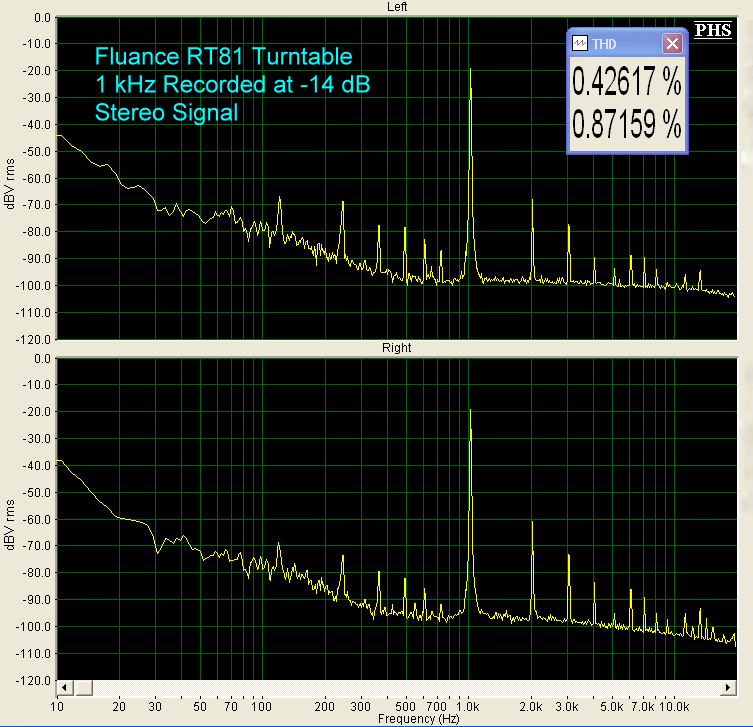
For testing cross-talk, I used a 1 kHz test signal, recorded at 0 dB, in only the left channel. You can see that a considerable amount of the signal is transferred to the right channel. This is cross-talk, which is not present on CDs (but is present to a small degree in preamplifiers and power amplifiers). The cross-talk is 20 dB lower than the test signal in the left channel, which is right on the factory specification (listed as Channel Separation).
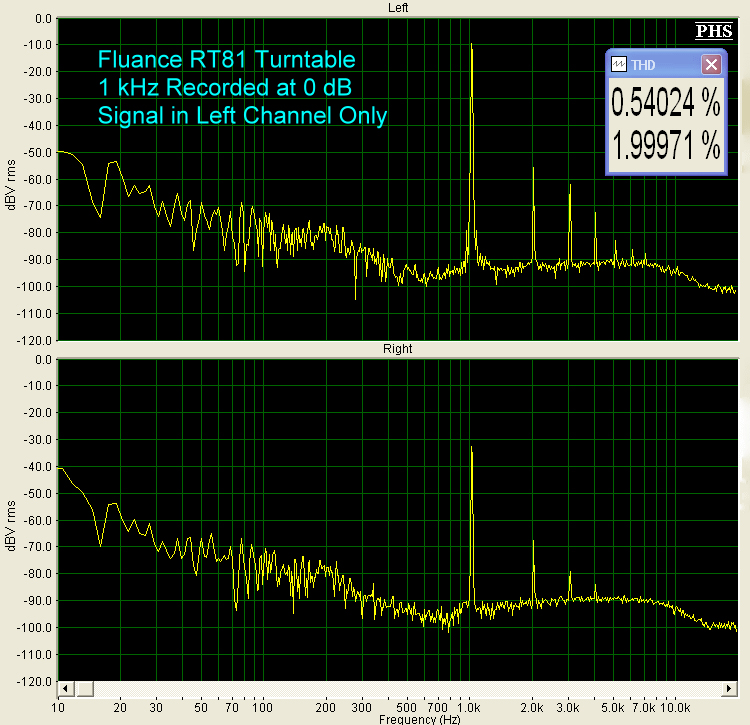
I did not detect any wow or flutter in the listening tests. I don’t have a way of measuring it in bench testing. This is a test that would be great to have on a test LP which would be specific for the Audio Precision, and for which Audio Precision would write the test script. I am hoping that with vinyl now being a huge market, we will see more Audio Precision-friendly test LPs being produced that include not only turntable and cartridge tests that are specific for turntables and cartridges, but the same kinds of tests we run on preamplifiers and power amplifiers. I sent a large list of tests to one of the test LP suppliers, but never got a response.
For example, it would be nice to see a track having 60 Hz and 7 kHz on both channels for testing Intermodulation Distortion, a track having those frequencies on one channel only, and also a track having 60 Hz on one channel and 7 kHz on the other channel to test Cross-channel Intermodulation Distortion. The tests on test LPs seem to be more oriented towards engineering and designing rather than product reviews.
For those of you who don’t know what wow and flutter are, they are basically drifts in rotational speed of the platter. Wow is drift from 1 Hz to 10 Hz, and flutter is drift above 10 Hz. I have seen reports which say that wow and flutter are audible at 0.06% and above, and others that say they are audible at 0.2% and above. People find the effects of drift at 4 Hz the most audible, and less audible when drift is below or above 4 Hz. The spectral peaks produced by wow and flutter are compounded with the peaks produced by rumble and noise that are caused by the motor, as well as noise produced by the stylus rubbing on the plastic surface where the musical tracks are located. Since wow and flutter are small peaks compared to the music and its harmonic distortion, wow and flutter would be audible only during very quiet musical passages.
Wow and flutter are generally specified as one number rather than stating the individual wow and flutter specifications. It would be nice to know both specifications and at which frequencies the wow and flutter occur.
I did not hear anything that I could identify as wow and/or flutter in the Fluance turntable, so the frequency of the 0.2% specification may not be at 4 Hz.
THE FLUANCE RT81 TURNTABLE is an Excellent Value, and is a Product that is Perfect for the Budding Vinyl Consumer.
- Amazing sound for the price
- Assembly is simple
- Pre-aligned tonearm and cartridge
- Higher output (0.5 volts) from the phono preamplifier
The Fluance RT81 turntable is a very inexpensive way to start your LP collection. It is easily assembled and does not require an outboard phono preamplifier, but if your receiver has a phono input, you can compare the two and choose the one that sounds best to you.
At $249.99, this turntable is a good choice among a large field of turntables in the less-than-$500 category.


